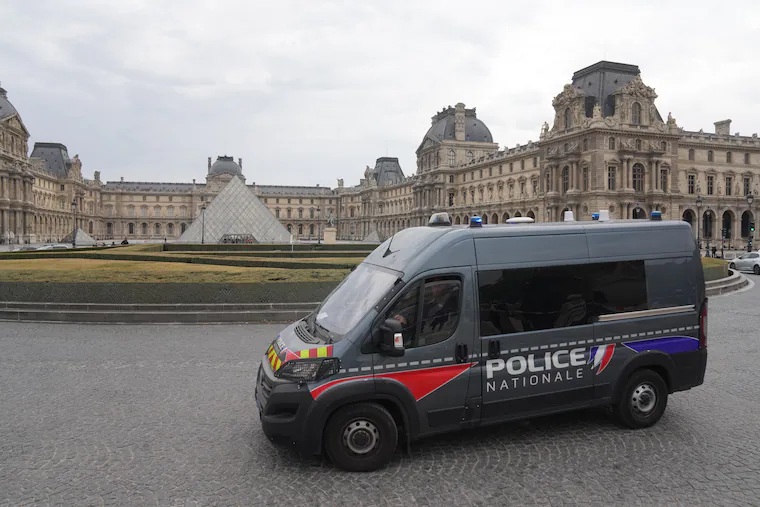Copyright The Philadelphia Inquirer

The world’s most-visited museum was closed Monday following a professional heist that resulted in the theft of priceless jewels. Within minutes, thieves entered and exited the Louvre on Sunday, taking eight treasures. The result? One of the highest-profile museum thefts in living memory amid a climate where museum staffs — worldwide, not just at the Louvre — are complaining about crowding, thin staffing, high turnover, and strained security. Here’s what we know so far. How did the Louvre heist happen? Within minutes, thieves rode up a basket lift outside the Louvre’s facade, forced open a window, smashed display cases, and fled with priceless Napoleonic jewels, officials said. The heist took place on Sunday, only 30 minutes after opening, with visitors already inside. The theft took four minutes inside the building and less than eight in total, according to French Culture Minister Rachida Dati, who called it a “professional” operation. “They went straight to the display windows,” Dati said. “They knew exactly what they wanted. They were very efficient.” Sunday’s theft focused on the gilded Apollo Gallery, where the crown jewels are displayed. Alarms brought Louvre agents to the room, forcing the intruders to bolt on motorbikes, but the robbery was already over. It’s unclear how many people took part in the theft and if they had inside assistance. French media reported there were four perpetrators, including two dressed as construction workers. Authorities have not commented on the specifics. What was taken from the Louvre? Eight objects were taken, according to officials: Empress Eugénie’s crown, which contains more than 1,300 diamonds, was apparently dropped by the thieves during the heist. It was damaged, but recovered outside the museum. All of the items are considered priceless, though officials have not disclosed an overall estimate. What will happen to the stolen jewels? The Louvre has been closed since the robbery on Sunday morning for investigation. Experts say the initial hours after a heist are critical before the scent grows colder and thieves have more time to dispose of the jewels. The big concern is that the thieves are motivated by commodity vs. art, and will scrap the priceless works for sale on the black market, breaking the pieces for their stones and melting down the precious metals. In doing so, the thieves can make more high-ticket sales while remaining undetected. Has this ever happened before at the Louvre? According to National Geographic, the Louvre has a long history of bold heists — but it’s been a while until now. In 1911, the Mona Lisa — then a lesser-known piece by Leonardo da Vinci — was taken by Vincenzo Peruggia, a former employee dressed in his old work uniform. No one noticed it was missing for over 24 hours. The painting was recovered two years later after Peruggia tried to sell it to another museum. In 1940, a portion of the Louvre’s collection was looted by occupying Nazis, though the museum’s director had already hidden most of its collection in a safe house off-site. There was the 1966 theft of antique jewelry, which was being transported back to France from a loan to a Virginia museum. Those jewels were recovered after being found in New York inside a grocery bag. A decade later, one group of thieves stole a Flemish painting, and months after that, another group stole French King Charles X’s jeweled sword. The sword is still missing. The most recent string of heists occurred in the nineties. In 1990, thieves cut a Renoir painting from its frame in broad daylight and also took ancient Roman jewelry and other paintings. In 1995, two pieces — a painting and a battle ax from a 17th-century bronze sculpture — were stolen. Finally, in 1998, a Camille Corot painting was cut from its frame and taken. It hasn’t been recovered. What about in Philly? Any heists? Yep. Philly-area museums have seen their fair share of art thefts over the years. Dating back to the eighties, several thefts or alleged thefts have occurred across the Philadelphia Art Museum, Rodin Museum, Penn University Museum, and more, according to Inquirer archives. Various thefts include a gold saw from Iraq and a 19th-century Chinese crystal ball taken from the Penn Museum in 1981 and 1988, a painting taken during a Philadelphia Art Museum after-hours party in 1984, and a bronze sculpture from the Rodin Museum in 1988 during a gunpoint robbery. The sculpture was recovered shortly afterward, and the alleged robber was arrested and charged. The crystal ball was also recovered. There’s also Frank Waxman, the Philly-based doctor who authorities said secretly amassed the largest known private collection of stolen art: about 150 pieces worth more than $2 million. The FBI raided his Rittenhouse condo in 1982 to find Rodins, Picassos, and more. Due to the statute of limitations surrounding his thefts, he was only convicted of taking eight pieces and served eight months in prison. In 2003, the Barnes Foundation said hundreds of items were missing from its collection, including a piece by Henri Matisse, a Jean Renoir ceramic vase, a mahogany Steinway piano, and historic recordings. It’s unclear whether the items were stolen or simply unaccounted for. No formal large-scale investigation took place. » READ MORE: Philadelphia owns more than 1,000 public artworks. Scores are missing. There was also an incident in 2017 where Michael Rohana, who was attending an after-hours ugly sweater party at the Franklin Institute, broke the thumb off a life-size Chinese terracotta warrior statue. Rohana described the incident as a “drunken mistake” and returned the thumb, which he had initially taken home. Still, it caused international turmoil, with Chinese officials accusing the Franklin Institute of carelessness with the artifact. The statue, which is called “The Cavalryman,” is insured for $4.5 million. Rohana went to court in 2019, eventually pleading guilty to a misdemeanor charge in 2023, where he was sentenced to five years’ probation, a $5,000 fine, and community service. In 2021, six Pennsylvania museums were reunited with an assortment of historic firearms stolen by one man almost 50 years earlier. Thomas Gavin admitted to targeting dozens of museums up and down the East Coast, taking valuable artifacts sometimes unnoticed for years. The Hershey Museum and Pennsylvania Farm Museum in Landis, Lancaster County, were among some of the museums impacted. Gavin’s crimes went cold for so long that the statute of limitations expired for many, leading him to only serve a day in prison for trying to sell a historic rifle. What does the jewel heist mean for museums’ futures? The latest Louvre heist comes amid a tense time for museums worldwide. Following the height of the COVID-19 pandemic, museums have been working to balance mass tourism, stretched-thin staff, and security upgrades. Locally, the Philadelphia Art Museum and its employees reached a settlement last year after a yearlong dispute over pay raises called for in their 2022 labor contract and a nearly three-week strike. At the Louvre, a June staff walkout over frustrations with overcrowding and chronic understaffing led to a delayed opening. Unions say mass tourism leaves too few eyes on too many rooms and creates pressure points where construction zones, freight routes, and visitor flows meet. Officials say security updates are underway at the Louvre as part of an $800 million modernization plan. But critics say the measures are too little, too late.



